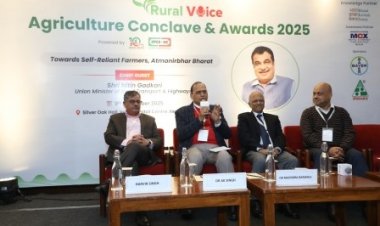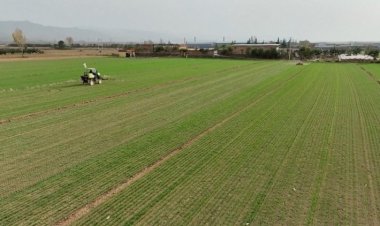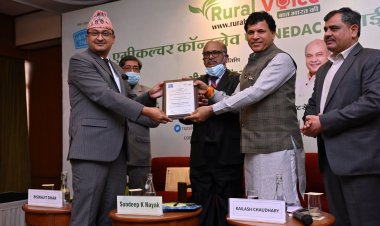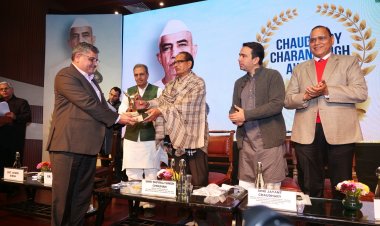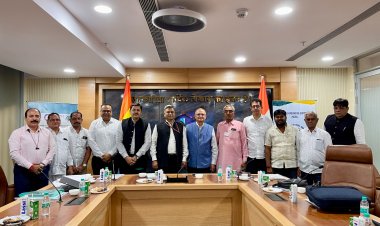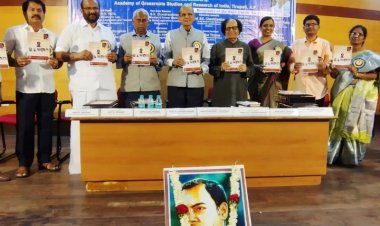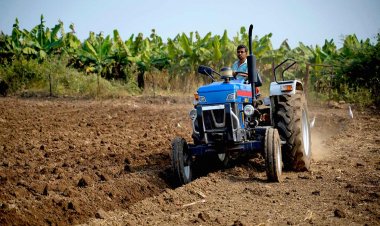Indian Agriculture Urgently Needs Public-Private Partnerships
The issue was discussed at a programme organised recently by Trust for Advancement of Agricultural Sciences (TAAS). Outcome of this programme was released as a policy brief by TAAS. The brief, Public-Private Partnership in Agriculture: A Way Forward, says that if the sector is to contribute meaningfully toward the government's goal of achieving a USD 5 trillion economy by 2025, agriculture’s growth must be sustained at around 4% to 5% per annum. Achieving this will require overcoming several critical obstacles.

India's agricultural sector, long considered the backbone of the country's economy, stands at a crucial juncture. Faced with stagnating yields, the depletion of natural resources, and the growing threat of climate change, Indian farmers are under immense pressure. This situation presents a serious risk to farm incomes and the nation's food security. As the country's population continues to rise, with increasing demand for diverse and high-quality food, India's agricultural system must undergo a transformation to meet the needs of its people. In light of these challenges, the call for public-private partnerships (PPP) in agriculture has gained significant traction. These partnerships offer a promising way forward, providing a framework to accelerate innovation, increase agricultural exports, and improve the livelihoods of millions of farmers.
The issue was discussed at a programme organised recently by Trust for Advancement of Agricultural Sciences (TAAS). Outcome of this programme was released as a policy brief by TAAS. The brief, Public-Private Partnership in Agriculture: A Way Forward, says that India’s agricultural sector contributes about 17% to the nation's gross domestic product (GDP) and employs a significant portion of the workforce. However, if the sector is to contribute meaningfully toward the government's goal of achieving a USD 5 trillion economy by 2025, agriculture’s growth must be sustained at around 4% to 5% per annum. Achieving this will require overcoming several critical obstacles. This policy brief has been edited by TAAS Chairman Dr. R.S. Paroda and others.
Listing the obstacles, the brief says that despite technological advancements, the yields of key crops have plateaued, leading to a widening gap between supply and demand. This stagnation threatens both food security and farmer incomes. Another problem is depletion of natural resources. The over-extraction of water, soil degradation from excessive fertiliser use, and loss of biodiversity have severely depleted the natural resource base on which Indian agriculture depends.
Climate change is a major problem. Extreme weather events- such as floods, droughts, and unpredictable monsoons- have become more frequent, making it increasingly difficult for farmers to maintain stable production. Apart from this, decline in farm income is also a major issue. With rising input costs, volatile markets, and fragmented landholdings, farmers are seeing their incomes decline. This situation has led to widespread rural distress and threatens the long-term viability of farming as a livelihood.
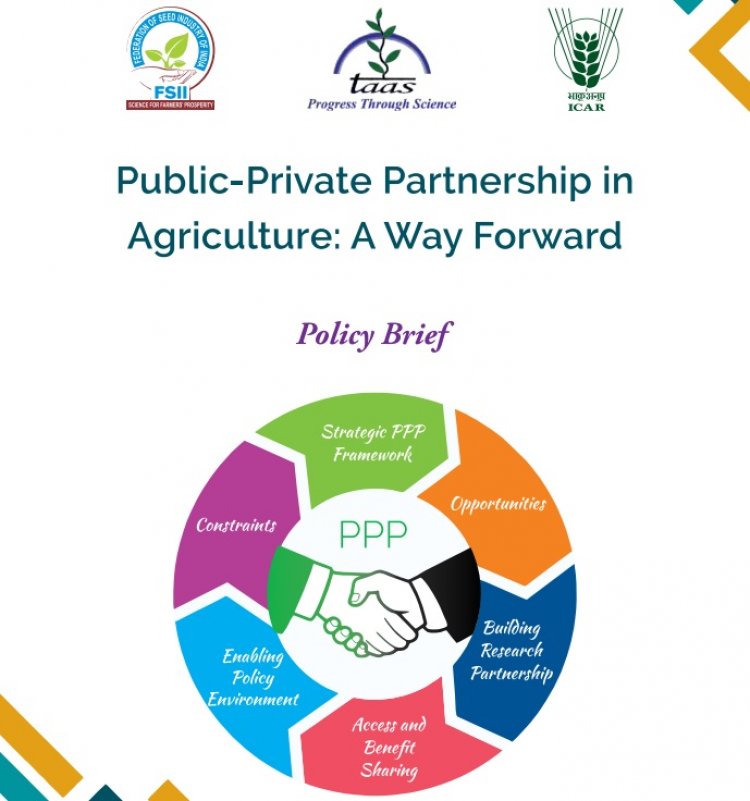
Addressing these challenges will require Indian agriculture to embrace new technologies and innovations that can enhance productivity, improve resource efficiency, and bolster resilience to climate change. Techniques such as marker-assisted selection (MAS), genetically modified (GM) crops, and genome editing can significantly increase crop yields and enhance resistance to pests, diseases, and environmental stresses.
Digital tools and artificial intelligence (AI) can provide real-time data on weather, soil conditions, and crop health, allowing farmers to make informed decisions and optimize their practices. Biotechnology offers solutions for developing climate-resilient and biofortified crops, which are essential for ensuring food security in the face of changing climatic conditions.
The brief says, India must increase its investment in agricultural research and innovation for development (ARI4D) to unlock the full potential of these technologies. Currently, India spends only 0.61% of its agricultural GDP on research, well below the global average. A recent study by the ICAR-National Institute of Agricultural Economics and Policy Research (NIAP) shows that every rupee invested in agricultural research yields a return of Rs 13.85, underscoring the critical need for increased investment.
Public-private partnerships (PPP) have emerged as a powerful tool for driving innovation and transforming Indian agriculture. While the public sector excels in research, infrastructure, and germplasm development, the private sector brings expertise in seed production, marketing, and distribution. By combining their strengths, these sectors can accelerate the development and dissemination of new technologies to benefit farmers.
However, for PPPs to succeed, several key constraints must be addressed. The public sector prioritizes social welfare, while the private sector focuses on profit. Aligning these differing goals can be a major challenge. There is often mistrust between public and private entities. The public sector may view the private sector as being too profit-driven and less concerned with farmers' welfare, while the private sector may see the public sector as inefficient and bureaucratic.
Policies governing intellectual property rights (IPR), licensing, and access to research facilities need to be streamlined to promote collaboration. Successful PPPs in Indian agriculture are few and far between, making it difficult to replicate best practices. Additionally, even when success is achieved, there is often insufficient data to validate and document these results.
Despite these challenges, there are ample opportunities for public-private collaboration in Indian agriculture. Collaborative research between public institutions and private companies can focus on developing climate-resilient, high-yielding, and biofortified crops. These initiatives can address national priorities such as improving nitrogen and water-use efficiency and developing herbicide-tolerant varieties.
Public research institutions can license their innovations to private companies for commercialization, ensuring that farmers have access to improved seeds and technologies. Public-private partnerships can focus on training farmers in new agricultural practices, such as direct seeding of rice (DSR) and high-density planting systems (HDPS), which can increase productivity while conserving resources.
The policy brief advises that to fully harness the potential of PPPs in agriculture, the government must create an enabling policy environment that encourages collaboration. Policies related to intellectual property rights, access to research facilities, and data sharing need to be more transparent and predictable. Additionally, providing incentives such as tax breaks or subsidies can encourage private-sector investment in agricultural research.
India can also learn from the successes of other countries. For instance, Brazil's EMBRAPA and Malaysia's MARDI have demonstrated how public-private collaborations can drive agricultural innovation, generate revenue for research institutions, and ensure farmers have access to affordable, high-quality products.
To strengthen India's agricultural sector and foster innovation, several key recommendations have been made in the brief. It says, establishing large-scale research facilities, including biotech laboratories and testing grounds for genetically modified (GM) crops, can provide a platform for innovation and collaboration.
Crop-specific consortia can pool resources and expertise to accelerate research and breeding efforts, especially for hybrid and composite varieties that can benefit smallholder farmers. The use of advanced molecular breeding techniques, big data, AI, and machine learning can revolutionize Indian agriculture and make research outcomes more efficient and accessible.
Aligning research priorities with consumer preferences can help develop crop varieties that meet both market demand and environmental needs. For PPPs to thrive, a stable and predictable policy environment is critical. This includes tax incentives, intellectual property protections, and benefit-sharing models.



 Join the RuralVoice whatsapp group
Join the RuralVoice whatsapp group

















